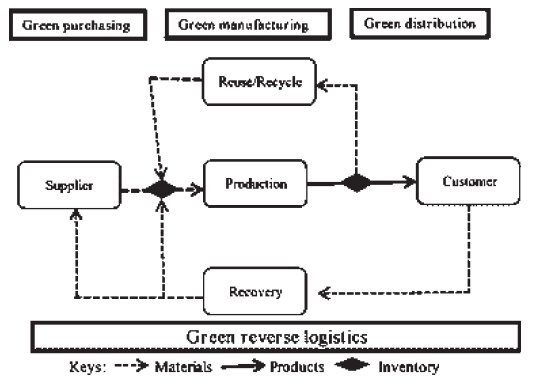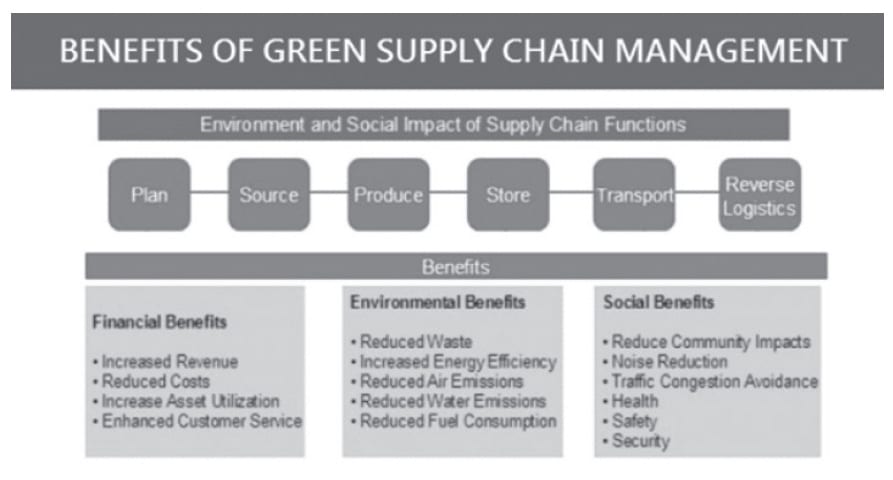Green supply chain management can be defined as Integrating environmental thinking into supply chain management, including ecological design of products, purchasing green materials and components, reengineering of manufacturing steps towards ecofriendly, reverse logistics management of the product after its useful life. The Global Supply Chain Forum defines SCM as “the integration of key business processes from end users through original suppliers that provide products, services, and information that add value for customers and other stakeholders”.Green supply chain makes the applications of the key sustainable development strategy outstand. It emphasizes how green practices can be adopted in firms to mitigate the environmental degradations and increase the economic and operational performance of firms, Integrating environmental thinking into supply chain management, including ecological design of products, purchasing green materials and components, reengineering of manufacturing steps towards ecofriendly, reverse logistics management of the product after its useful life. Building a green supply chain involves making trade-offs between minimizing your supply chain environmental impact and other business objectives including agility, efficiency, profitability, and customer service. Green supply chain management is achievable by organizations of any size and in any industry. Green supply chain management is an extension of supply chain management. It refers to assimilating environment thinking into supply chain management, comprising product design, sourcing and selection of material, process of manufacturing the product, delivery of the same, and management of the product after its usage. Green supply chain management not only improves operations but also agility, adaptability and promotes alignment. This process is eco-friendly and becomes a part of the corporate social responsibility. Many in the supply chain world assume that fast, lowcost supply chain options are incompatible with a green supply chain. This, however, may not be the case. That’s because green initiatives can often be cost savers. For example:
Reduction in shipping typically means less fossil fuel is burned.By consolidating and optimizing material and packaging usage, fewer packing products are consumed.When hazardous materials are taken out of the supply chain, lower costs are associated with handling and disposing of the materials.When waste is minimized, so too are the costs associated with purchasing and disposal.
With the help of Green Supply Chain practices operational efficiencies can be improved. Following are some of the benefits that can be realized out of this initiative which is termed as CI benefits:-
(CI) Continuous Innovations- It helps to alleviate risk and gives momentum to innovations.(CI) Continuous Improvements- Analyzing GSCM activities generally leads to innovative processes and regular improvements(CI) Continuous Interactions – It involves negotiating policies with all the stakeholders like suppliers and customers, resulting into better alignment of business processes and principles.
Green practices in supply chain management
Some well-known green practices adopted by companies worldwide are as follows;
Green material sourcing
Green sourcing means sourcing or purchasing materials and components which have ecofriendly characteristics as reusability, recyclability and nonuse of hazardous/ dangerous chemicals.With more and more concerns on environmental protection, procurement professionals have been motivated to reconsider their existing sourcing, purchasing strategy and their impact on environmental sustainability.
Green marketing
Green marketing encompasses a broad range of marketing activities (e.g., planning, production,, process, price, promotion and after-sale service) designed to focus on the goal of organization to mitigate the harmful effects of their products. Green marketing practice promotes the products with environmental friendly properties. It contains the activities that can satisfy human desires of minimum negative effects on the environment.
Green distribution and warehousing
Green distribution and warehousing can reduce the waste and play an important role in energy reduction besides significantly improving overall performance of organization with better corporate image.
Green manufacturing
Green manufacturing practices involve socially and environmentally accountable practices to mitigate harmful effects of manufacturing. Green practices reduce waste and improve the efficiency of manufacturing processes
Ecological design
Research has highlighted that 80% impacts on environment from product and related processes could be controlled with the adoption of ecological design in supply chain management. Ecological design incorporates many ideas like using cleaner technology processes, green raw material and components. Green design of products also supports reusing, recycling and remanufacturing of products, which not only helps firms to improve their environmental performance but also provide opportunity to reduce their costs
Green transportation and reverse logistics
Green transportation and reverser logistics practices provide opportunity to organizations to reduce their costs. Logistics overheads can be reduced through promoting efficiency of transportation system. The logistics activities integrated with rehabilitation comprise the practice of reverse logistics (reusing, recycling, and remanufacturing), which can produce the products that can be used again for customers.
Renewable energy and biofuels
Global logistics and supply chain operations mainly depend on energy as well as fossil fuel, which are the main cause of climate change, global warming and pollution with greater carbon and greenhouse gas emissions. Use of renewable energy and biofuels reduces carbon emissions and facilitate sustainable environmental and economic growth
Green Supply Chain Principles
Reduce environmental impact of all products, processes and materials
Reduce environmental impact over the full life cycle of all products, processes, and materials by measuring, setting reduction goals and monitoring progress.Develop products and processes that are less harmful to the environment.
Minimize adverse environmental impact on air, land, and water.
Reduce greenhouse gas emissions in production, logistics and other processes, by establishing a baseline, setting reduction goals and monitoring progress.Minimize and properly manage waste.Minimize water consumption and water-related risks
Minimize the consumption of natural resources, raw materials, and fossil fuel inputs
Promote recycling and evaluate the potential to use recycled or used materials when they are available.Design and deliver to all customers, the most sustainable packaging by assessing its quality and cost over the full life cycle.
Greening the Supply Chain
Here’s what you can do to adopt a ‘Green Supply Chain Strategy.’
Commitment:
• Gain executive commitment and sponsorship to visibly support program goals, strategies, and execution plans.Identify an accountable program champion.Define metrics and benchmark environmental impact in areas like waste generation, energy consumption, emissions, etc.Set targets and devise policies that offer guidance on how to achieve targets at every level of the enterprise and across the product life cycle.Ensure policy compliance goal/target achievement across the extended enterprise leveraging executive support.Develop a green corporate culture by offering training and workshops to employees and stake holders, as well as incentives and recognition.Consider acquiring green certifications and performing green audits
Supply Chain Visibility And Monitoring:
Map your supply chain end-to-end to gain visibility to your multi-tier supplier network and sub-tier suppliers.Consider using a third-party supplier onboarding/ network mapping service to reduce the cost of implementation and ongoing updates.Monitor supply network for environment-related news such as chemical spills and environmental compliance breaches
Green Procurement:
Procure materials/parts from suppliers who adhere to green principals and processes (e.g. lean manufacturing) and have a strong green policy and standards.Deal with suppliers who acquire ISP14000, OHSAS18000, RoHS directives and behest stringent norms to control hazardous substances.Ensure that the material being purchased is non-toxic and recyclable.Perform quality checks at material inflow points.Implement inventory control strategies selectively to reduce stock and eliminate warehousing costs.
Green Manufacturing:
Incorporate manufacturing process(es) that curb or control pollution/wastage.Design and redesign products to minimize production complexity, reduce energy consumption, and increase the product life span.Use non-toxic, lead-free materials for manufacturing.Incorporate lean manufacturing to:
Incorporate manufacturing process(es) that curb or control pollution/wastage.
Design and redesign products to minimize production complexity, reduce energy consumption, and increase the product life span.Use non-toxic, lead-free materials for manufacturing.Incorporate lean manufacturing to:
Green packaging:
Downsize packaging to reduce material consumption.Use recyclable, reusable, non-toxic, and biodegradable packaging material.Design warehouses to reduce energy consumption.
Green logistics:
Hire vehicles designed to control for carbon emissions.Plan the transportation route to reduce mileage.Plan reverse logistics to collect used products and packaging from customers to recycle/reuse.
Conclusion
In the world, as the environmental awareness is increasing, firms are facing huge pressure from different stakeholders including government and customers to mitigate their harmful effect on the environment. Indeed, corporate sector needs to consider integrating their business practices in service and manufacturing industry with sustainability and reducing end-to-end supply chain costs and associated undesirable outcomes to achieve competitive advantage. The main barriers to implementing GSCM can be identified as technology, knowledge, finances, outsourcing and management. Designing and to implementing a nature-friendly supply chain will help, in the long term, the planet, consumers and companies. Green supply chain can reduce the environmental pollution and production costs and it also can spur economic growth, create competitive advantage in terms of greater customer satisfaction, positive image and reputation and provide better opportunity to export products in pro-environmental countries. Recommended
BackorderBill of Lading MeaningSupply Chain ManagementCMA Inter ResultCMA Final ResultCMA Inter Time TableCMA Pass Percentage

